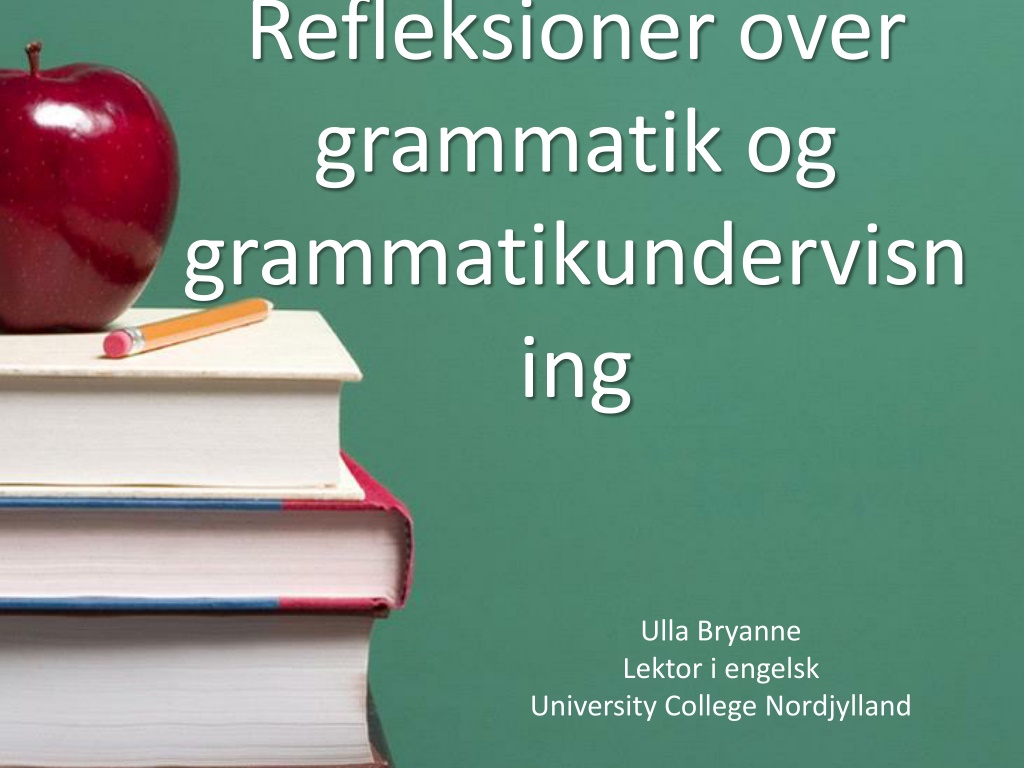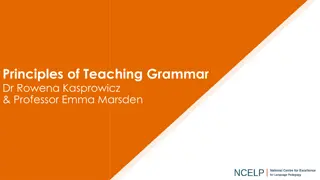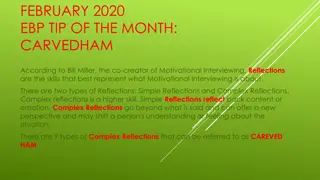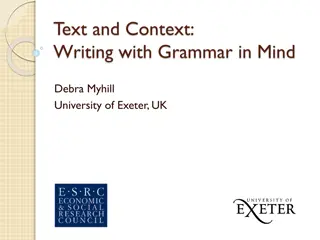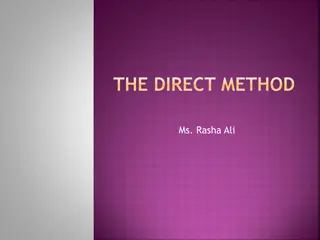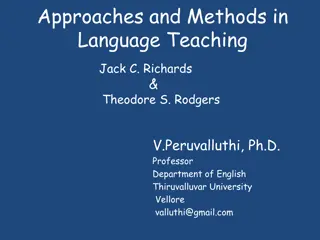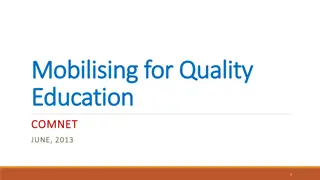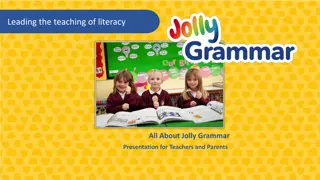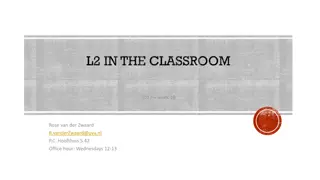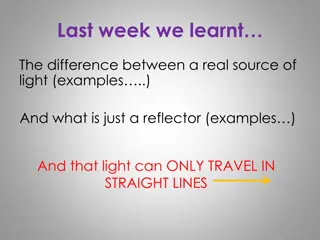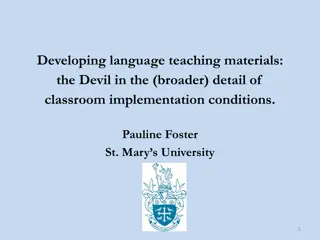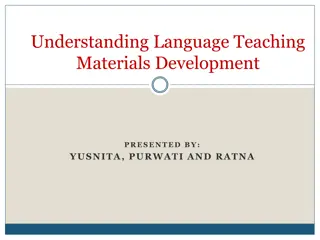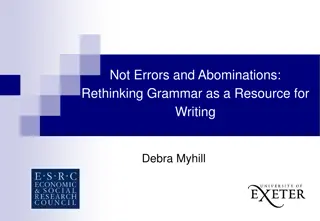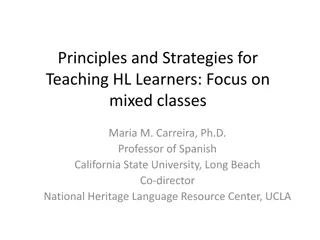Exploring Reflections on Grammar and Grammar Teaching in Language Education
Delve into a comprehensive examination of grammar and its instructional methods in language education through the insights shared by Ulla Bryanne, an English lecturer at University College Nordjylland. The content covers various aspects such as the transformation of students into teachers, the essence of grammar, effective language learning approaches, and the challenges faced in teaching and learning grammar. Additionally, it addresses dilemmas encountered in working with grammar, the dimensions of language, and specific grammatical structures posing difficulties for Danish learners.
Download Presentation

Please find below an Image/Link to download the presentation.
The content on the website is provided AS IS for your information and personal use only. It may not be sold, licensed, or shared on other websites without obtaining consent from the author. Download presentation by click this link. If you encounter any issues during the download, it is possible that the publisher has removed the file from their server.
E N D
Presentation Transcript
Refleksioner over grammatik og grammatikundervisn ing Ulla Bryanne Lektor i engelsk University College Nordjylland
Program 1.N r studerende bliver l rere 2.Hvad er grammatik? 3.Hvordan l rer man sprog? 4.Hvordan kan man undervise i grammatik?
Nr studerende bliver l rere
Hvordan Hvordan blev undervist undervist i i engelsk grammatik grammatik i i gymnasiet blev I I selv engelsk gymnasiet? ? selv
Forskellige dilemmaer i arbejdet med grammatik Hvorfor arbejde med grammatik? Pr skriptiv eller deskriptiv? Proaktiv eller reaktiv/integreret? Teaching grammar or teaching learners? Deklarativ eller procedure viden? Induktiv eller deduktiv? P dansk eller engelsk?
Hvad Hvad h rer undervisning undervisning i i grammatik grammatik? ? h rer med med til til
Sprogets tre dimensioner FORM MEANING How is it formed? (Accuracy) MORPHOSYNTAX What does it mean? (Meaningfulness) SEMANTICS USE When/Why is it used? (Appropriateness) PRAGMATICS Based on Celce-Murcia & Larsen-Freeman: The Grammar Book, p. 4
Sprogets tre dimensioner For each of these grammatical structures, which of the three dimensions do you think Danish learners will have most problems with: how it is formed, what it means, or when and why to use it? 1. Phrasal verbs (e.g. My boyfriend ran up a huge phone bill) 2. The simple or continuous perspective (e.g. She painted/was painting the house) 3. The ly of adverbs (e.g. She took it very seriously) 4. Irregular plural (e.g. mouse mice) Bruntt & Bryanne, p. 34
Hvordan lrer man et sprog?
sprogtilegnelse Fig. 2.3
Intersprogsudvikling Ordindsamlingsfase Udfyldningsfasen Sofistikeringsfasen
Traditional assessment: Interlanguage analysis: - Focus on the target language - Compares learner language to the target language - Focus on product - Points out mistakes - Focus on the things the learner cannot do - Summative assessment - Focus on the learner language - Sees learner language as a language in progress - Focus on process - Points out progress - Focus on the things the learner can do - Formative assessment Fig. 2-2. Differences between the traditional way of assessing learner language and the interlanguage analysis Bruntt & Bryanne, p. 22
Hvordan kan man undervise i grammatik?
Sprogets tre dimensioner - hvordan l res de? FORM-dimensionen: Mange gentagelser Task-Based Learning MEANING-dimensionen: Dictogloss L bediktat USE-dimensionen: Rollespil
Eksempel p induktiv velse 1. If his girl friend is the answer to a question, what is the question we could ask to get this answer in the following sentence? Scott gave his girl friend a bunch of flowers 2. Form questions that will give you the words in boldface as answers: a. Mr Block found his daughter a job b. Bob made a bookcase for Sally c. Go find me a pencil d. I explained the problem to my dog e. Peter gave the book to Alice, who was his girlfriend at the time f. He asked a favour of her 3. The words in bold are Indirect Objects in the sentences. Form a rule that will help you find the Indirect Object. Why are IOs often persons? What does the IO do in a sentence? 4. Have you noticed what forms IOs can have? 5. In which order do we often find the DO and IO? What happens with the form of the IO if we use the order IO + DO? Bruntt & Bryanne, pp. 121-122
Eksempel p automatiseringsvelse 1. Here are some dilemmas. Discuss in groups what you would do in the situations below? You might start: I would or I might . Think of other dilemmas you could meet and discuss how to solve them: 2. Your parents don t approve of your new girl-/boyfriend Your best friend and you both have spare time jobs in the same shop. You discover that (s)he has stolen 2,000kr You fall in love with the boyfriend or girlfriend of your best friend. A classmate cheated in the last English test. Should you tell someone? Your friend has bought a new pair of jeans and thinks she looks absolutely fantastic. But you actually think they don t suit her at all and now she wants to wear them on Friday when she hopes to get a date with a boy she has a crush on. Would/should you tell her? Bruntt & Bryanne, web chap. 13, 2-6
G ind p: http://samfundslitteratur.dk/b og/handbook-language- detectives V lg kapitel 10 V lg Web activity 5
Integreret grammatikundervisning I tekstl sning F lles skrivning
Read the following two texts: A. When Mr and Mrs Dursley woke up on the dull, grey Tuesday our story starts, there was nothing about the cloudy sky outside to suggest that strange and mysterious things would soon be happening all over the country. Mr Dursley hummed as he picked out his most boring tie for work and Mrs Dursley gossiped away happily as she wrestled a screaming Dudley into his high chair. None of them noticed a large, tawny owl flutter past the window. B. When Mr and Mrs Dursley woke up on the Tuesday our story starts, there was nothing about the sky outside to suggest that things would soon be happening all over the country. Mr Dursley hummed as he picked out his tie for work and Mrs Dursley gossiped away happily as she wrestled Dudley into his chair. None of them noticed an owl flutter past the window Rowling, J. K.: Harry Potter and the Philosopher s Stone, Bloomsbury, 1997, pp.7-8.
1. Which text enables you to picture and characterize situations, things and characters precisely and vividly? Explain which text you prefer and why. 2. Which words are missing in text B and which word class do they belong to? 3. Which words do they describe and which word class do they describe? 4. What can you now conclude regarding adjectives? 5. Can you think of other situations or genres in which you would use a lot of adjectives? 6. Discuss this exercise from a teacher s perspective, e.g. can you use this exercise with pupils?
The Teaching-Learning Cycle Setting the context Teacher modelling and deconstructing Students constructing independently Teacher and students constructing jointly
Hvad Hvad er er sv rt FORM? FORM? MEANING? MEANING? USE USE? sv rt ved ved verbaltiderne verbaltiderne? ?
Event BEFORE AT THE TIME (point of reference) AFTERWARDS Axis has sung (the present perfect) sings (the present) is going to/will sing (the simple future) Present Event BEFORE AT THE TIME (point of reference) sings (the present) sang (the past) sang (the past) AFTERWARDS Axis has sung (the present perfect) had sung sang + Adverbial (the past perfect or the simple past + Adv.) will have sung (future perfect) is going to/will sing (the simple future) sang/would sing (habit) (the simple past or the future of the past) (the simple past or the future of the past) Present had sung sang + Adverbial (the past perfect or the simple past + Adv.) sang/would sing (habit) Past Past will sing (the simple future) will sing (the simple future) Future will have sung (future perfect) will sing (the simple future) will sing (the simple future) Future
G ind p: http://samfundslitteratur.dk/b og/handbook-language- detectives V lg kapitel 7 V lg Web activity 33 Web activity 34
GRAMMAR GRAMMARING Grammar is Grammar is something that is something that is done done, rather than , rather than something that is something that is known known. . Bruntt & Bryanne, p. 20
Litteratur Bruntt, Karen Lassen & Ulla Bryanne: Handbook for Language Detectives: Learning and Teaching English Grammar. Samfundsfag. 2012 velser hertil: http://samfundslitteratur.dk/bog/handbook-language- detectives#tab2 Celce-Muria, Marianne & Diane Larsen-Freeman: The Grammar Book: An ESL/EFL teacher s Course. Heinle & Heinle. 1999 Larsen-Freeman, Diane: Teaching Grammar: From Grammar to Grammaring. Thomson-Heinle. 2003
